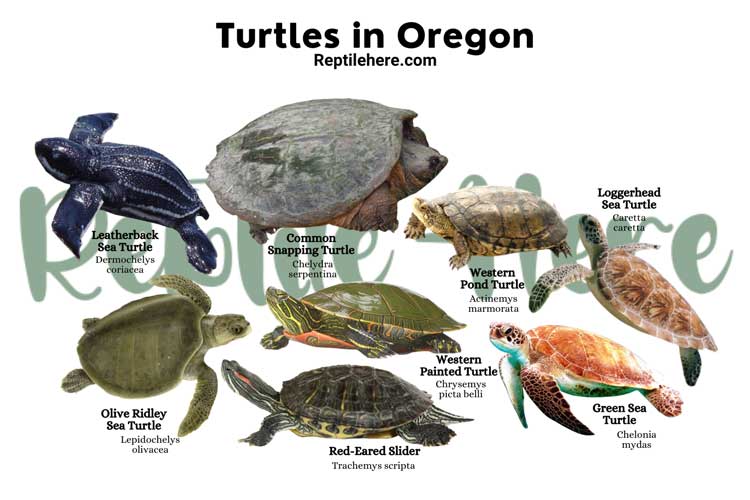Turtles in Oregon – 8 Species That are Found Here
Oregon is home to 8 species of turtles. But ONLY two of these turtles are truly native to the state and include the western pond turtle and western painted turtle.
These native species are mostly spotted in the Portland area and the Oregon Conservation Strategy highlights them as Special Case—meaning their populations are declining and they need special help.
Non-native species of Oregon include the red-eared sliders and common snapping turtles. Moreover, they also boast 4 sea turtle species, ranging from the leatherback to the Olive Ridley sea turtles.
Our guide below will walk you through each of the turtle species (both native and invasive) of Oregon and basic information like habitat, diet, size, lifespan, and more.
8 Types Of Turtles in Oregon
Contents
1. Common Snapping Turtle
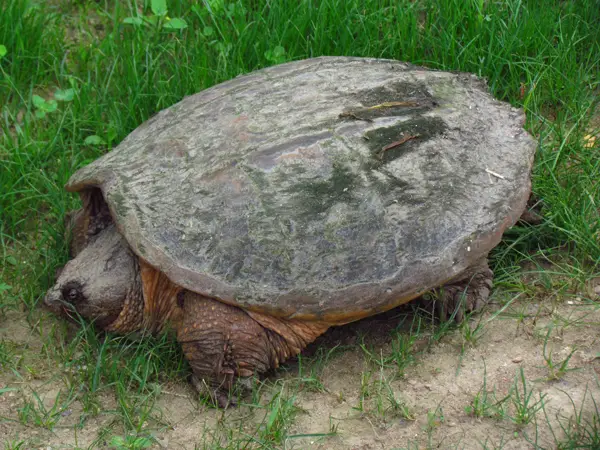
- Scientific name: Chelydra serpentina
- Common name: Snapping Turtle
- Family: Chelydridae
- Size: 8 to 18 1/2 inches
- Lifespan: 30 to 50 years or more
- Conservation status: Least Concern
Common snapping turtles are widespread throughout Oregon. An average adult is pretty large and has a shell length of 18½ inches long. It is, no doubt, the biggest guy in Oregon!
This species has a chunky head, a long tail, and large webbed feet. The shell color is black or olive and has no distinct pattern.
These Oregon snapping turtles are known for their powerful jaws—they’re so strong that these turtles eat other turtles!
You’ll find them in waterbodies with muddy bottoms in Oregon. Examples include marshes, ponds, lakes, rivers, and even shallow streams
They generally prefer waters with aquatic vegetation in plenty and foods such as fish, frogs, birds, etc.
These Oregon turtles generally show docile behavior but can get quite aggressive if taken out of water. The best way to calm it is to take it back to the waters, where it feels safe.
2. Western Pond Turtle
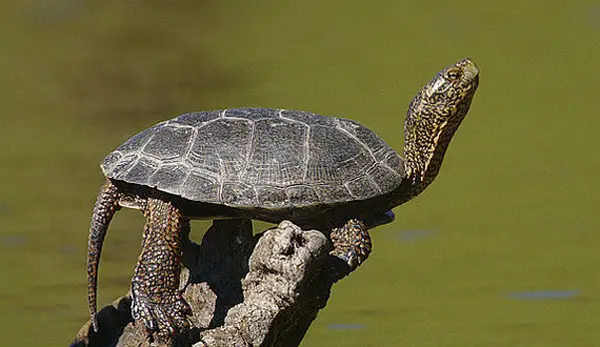
- Scientific name: Actinemys marmorata
- Common name: Western Pond Turtle, Pacific Pond Turtle
- Family: Emydidae
- Size: 6 to 8 inches
- Lifespan: 50 years
- Conservation status: Vulnerable
The Western Pond Turtle is a small-to-medium-sized turtle native to Oregon.
Mind you, it is the only freshwater turtle species native to Oregon. It can be found in the State’s creeks, ponds, lakes, and other suitable water bodies.
Carapace coloring for this turtle can be black, brown, or dark green, with some yellowish spots. Patterns of lines or dots also usually radiate from the center of each shell plate of this tortoise.
Also, the limbs of a western pond turtle found in Oregon feature prominent scales while its head is webbed or spotted with black.
Western pond turtle species is omnivorous and its diet includes insects, tadpoles, frogs, and even carrion. For this reason, it prefers living in waterbodies with plenty of aquatic vegetation such as cattails, water lilies, watercress, etc.
The Oregon western pond turtle has suffered habitat loss due to development, low reproduction, predators, and invasive aggressive non-native pet turtles being released into their environment.
All these factors make the species population in Oregon state greatly endangered.
3. Western Painted Turtle
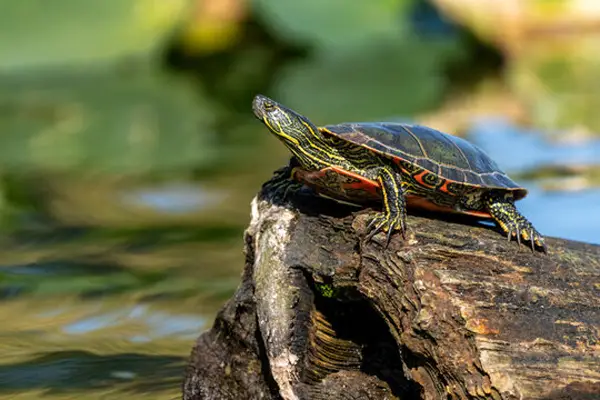
- Scientific name: Chrysemys picta belli
- Common name: Westland Painted Turtle
- Family: Emydidae
- Size: 4 to 10 inches
- Lifespan: 30 to 40 years
- Conservation status: Vulnerable
The Western painted turtle is a subspecies of painted turtle and is also found in Oregon waterbodies.
This turtle is identified by an oval-shaped carapace that lacks a ridge in the middle. The carapace is usually dark olive or black in color.
The lower side of the shell is usually red, with multiple dark markings in the center. And the skin itself is covered with yellow stripes.
Westland painted turtles of Oregon are aquatic and their webbed feet help propel them in the waters.
The most common habitats for this turtle in Oregon include slow-moving rivers, shallow streams, and lakes. They choose these areas because they can easily find food.
Given that they’re omnivorous, they feed on aquatic vegetation as well as meat from insects, snails, shrimps, tadpoles, and earthworms.
Their hatchlings are more carnivorous to help take in more proteins for building muscle.
4. Red-Eared Slider
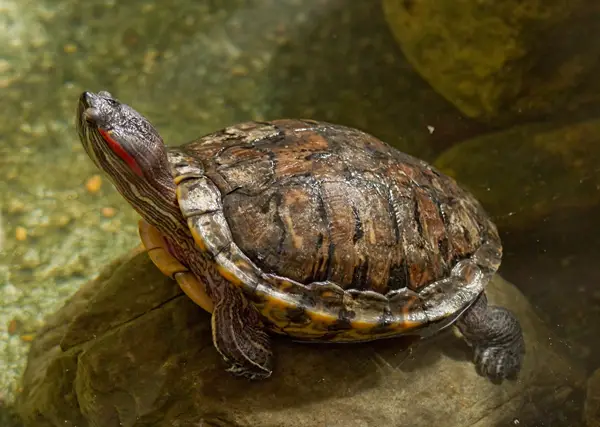
- Scientific name: Trachemys scripta
- Common name: Red-eared Slider, Red-eared Terrapin
- Family: Emydidae
- Size: 7 to 11 inches
- Lifespan: 30 to 40 years
- Conservation status: Least Concern
The red-eared slider is a sub-species of pond sliders and a native species of Oregon. It is a semi-aquatic turtle and prefers living in marshes, ponds, lakes, and creeks.
A red-eared slider gets its name from the small red stripe surrounding its ears (or behind the eye), and its ability to quickly slide off logs and rocks into the water.
Generally, the skin and shell coloration of this slider can be brown or black, with yellow stripes covering the skin.
The red-eared sliders of Oregon are pretty large and the adults reach 7-12 in length (though females are generally larger than males).
These Oregon pond sliders are omnivorous and like eating fish, snails, insects, and aquatic vegetation. They also eat land vegetation, including fruits and vegetables.
Also read: Turtles In Georgia
5. Green Sea Turtle
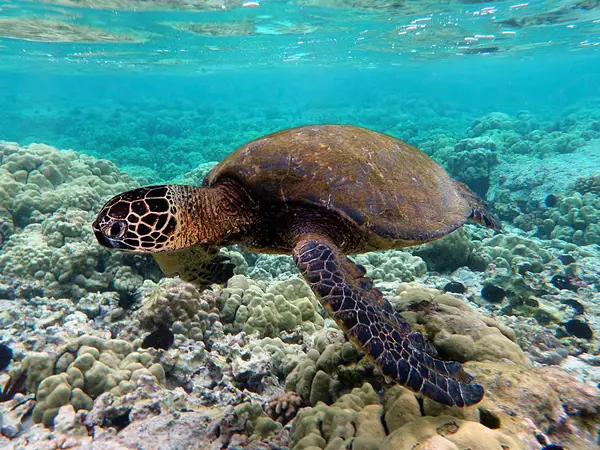
- Scientific name: Chelonia mydas
- Common name: Green turtle, Pacific green turtle, Black sea turtle
- Family: Cheloniidae
- Size: 2 to 5 feet
- Lifespan: 60 to 70 years
- Conservation status: Endangered
The green sea turtle species is classified among the largest hard-shelled sea turtles in Oregon. It can reach up to 4 feet in length and weighs up to 400lbs.
This species is characterized by scutes that run down the middle; they’re 4 on each side. The shell color can be gray, dark brown, or olive with a yellow-to-white bottom shell or plastron.
It also features a serrated beak on its lower jaw and two large scales resign between the eyes.
Males are generally larger than females and have longer tails. The females lay their eggs on the beach and use their paddle-shaped flippers to easily burrow in the sand when laying eggs. A single green turtle can lay up to 200 eggs!
This Oregon sea turtle species gets its name from its primary diet which consists of age and seagrasses (mind you, this diet is responsible for tinting its cartilage green).
Green turtles in Oregon are usually found in tropical as well as subtropical waters throughout the years. They live in coastal lagoons and bays in Oregon.
They also tend to migrate to cooler temperatures and even boreal waters when the weather gets warmer.
6. Leatherback Sea Turtle
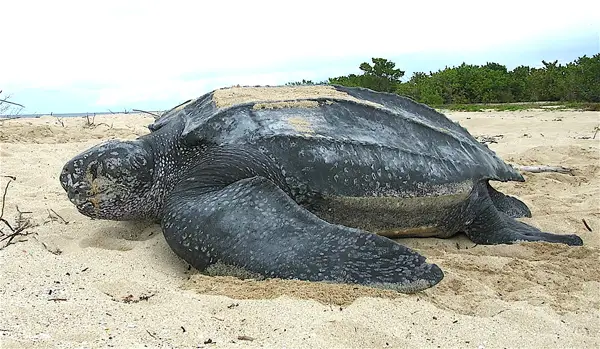
- Scientific name: Dermochelys coriacea
- Common name: leathery turtle, trunk turtle, Lute turtle, luth
- Family: Dermochelyidae
- Size: 5 to 6 feet
- Lifespan: 50+ years
- Conservation status: Vulnerable
The leatherback sea turtles are found in Oregon state and are known to grow to mammoth sizes (up to 6 feet!). An average adult can also weigh as heavy as 540lbs (or heavier!).
Leatherback turtles usually have black shells. And they differ from other species of turtles with their smooth leathery carapace and skin. Their upper shell is made up of a flexible layer of dermal bones covered by tough and oily connective tissue and smooth skin.
The body of this turtle is barrel-shaped and then tapered to the rear. They have a total of 7 longitudinal dorsal ridges and their whole body is almost completely black, with some variable spotting.
Leatherback turtles in Oregon have tooth-like cusps that work closely with their sharp-edged jaws to enable them to easily feed on jellyfish, salps, and other gelatinous zooplankton.
As for the habitat, these turtles of Oregon are fond of tropical and subtropical waters all year round. But they tend to migrate to cooler, temperate, and boreal waters during warm weather.
Note that this species is highly migratory and can swim as many as 10,000 miles in a year between foraging and nesting grounds.
They’re also excellent divers—with the deepest diving record standing at whopping 4,000 feet!
7. Loggerhead Sea Turtle
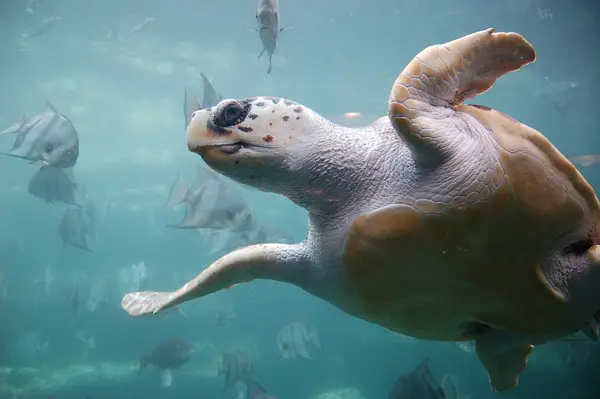
- Scientific name: Caretta caretta
- Common name: Loggerhead, Loggerhead Sea-Turtle
- Family: Cheloniidae
- Size: 3.5 feet
- Lifespan: 70+ years
- Conservation status: Endangered
Loggerhead sea turtles boast their place as the most abundant sea turtle species in the United States and are found in many states, including Oregon.
These turtles are pretty big and can reach up to 3.5ft in length. They weigh up to 350 pounds and can live for a whopping 70 years or more.
A loggerhead is distinguished by a slightly heart-shaped carapace that’s reddish brown in color, with pale yellow plastron. Some species also feature yellow-bordered scutes.
This turtle species of Oregon gets its name from its large head. It has powerful jaws that enable it to feed on a variety of foods including conch, whelks, insects, jellyfish, gastropods, and algae.
The loggerhead turtles in Oregon are usually found in coastal regions, especially in shallow bays.
They prefer living in temperate, tropical, and subtropical waters all year round. However, they also tend to migrate to sandy ocean beaches during nesting time.
8. Olive Ridley Sea Turtle
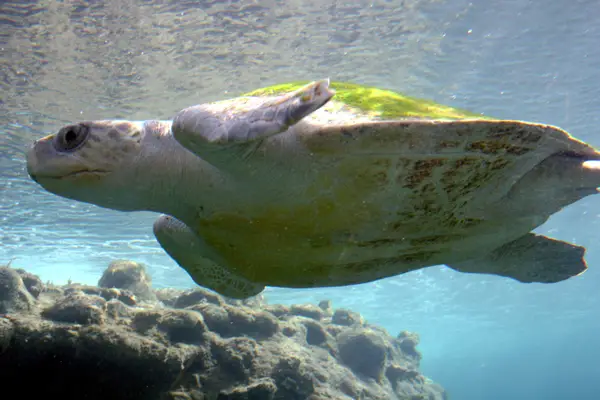
- Scientific name: Lepidochelys olivacea
- Common name: Pacific ridley sea turtle
- Family: Cheloniidae
- Size: 2.5 feet
- Lifespan: 50 years
- Conservation status: Vulnerable
Olive ridley sea turtles are much smaller than other species of sea turtles found in Oregon. They reach a maximum of 2.5 feet in length and weigh up to 100 pounds. And they have an average lifespan of up to 50 years.
An olive ridley sea turtle has a heart-shaped carapace with olive to grayish-green in color. The shell features around 5 to 9 scutes. These turtles are generally omnivorous and feed on crustaceans, fish, jellyfish, mollusks, algae, and salps.
These Oregon sea turtles can opt to nest in large groups or by themselves. In the event of a mass nesting, the female turtles usually gather in large groups offshore on the nesting beaches.
This is then followed by a vast number of turtles moving ashore to nest (this event is usually referred to as arribada, a Spanish word for arrival).
The arribada is marked by numerous (hundreds of thousands) pregnant females coming ashore to lay eggs. Due to the high density of nesting experienced at the nesting beaches, the females end up digging up clutches of eggs laid by other females as they try to find a place for their eggs.
Olive ridley turtles in Oregon are usually found in tropical and subtropical waters all year round. Though they tend to migrate to boreal waters when the climate gets warmer.
Related: Turtles in New York
Conclusion
Oregon’s list of turtles features both aquatic and sea turtle species. However, only two of these turtles are native to the state and include the western pond turtle and western painted turtle.
The rest are non-native and include red-eared sliders, common snapping turtles, and sea turtles.
Bear in mind that the population of the two native species in Oregon is declining and are listed under special case by the relevant authorities in the state.
Luckily, measures have been put in place to help make their survival much easier and prevent them from becoming extinct.


